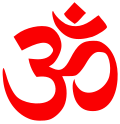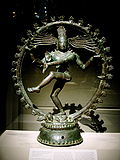Tirumurai
| Part of a series on |
| Shaivism |
|---|
 |
|
|
| The twelve volumes of Tamil Śaiva hymns of the sixty-three Nayanars | ||
| Parts | Name | Author |
| 1,2,3 | Tevaram | Sambandar |
| 4,5,6 | Tevaram | Thirunavukkarasar
|
| 7 | Tevaram | Sundarar |
| 8 | Thirukkovaiyar |
Manickavasagar
|
| 9 | Thiruvisaippa &Thirupallandu |
Various |
| 10 | Thirumandhiram |
Thirumular
|
| 11 | Saiva Prabandham | Various |
| 12 | Periya Puranam | Sekkizhar
|
| Paadal Petra Sthalam | ||
| Paadal Petra Sthalam | ||
| Rajaraja I | ||
| Nambiyandar Nambi | ||
| Topics in Tamil literature | ||
|---|---|---|
| Sangam Literature | ||
| Five Great Epics | ||
Silappatikaram |
Manimekalai | |
Civaka Cintamani |
Valayapathi | |
| Kundalakesi | ||
| Five Minor Epics | ||
| Neelakesi | Culamani | |
| Naga Kumara Kaviyam | Udayana Kumara Kaviyam | |
| Yashodhara Kaviyam | ||
| Bhakti Literature | ||
| Naalayira Divya Prabandham | Kamba Ramayanam
| |
| Tevaram | Tirumurai | |
Tamil people
| ||
Sangam |
Sangam landscape | |
Tamil history from Sangam literature |
Ancient Tamil music | |
| edit | ||
| Part of a series on |
| Hindu scriptures and texts |
|---|
 |
| Related Hindu texts |
Tirumurai (
History and background
The
Poets
| Tirumurai | Hymns | Period | Author |
|---|---|---|---|
| 1,2,3 | Tevaram | 7th century CE | Sambandar[5][6] |
| 4,5,6 | Tevaram | 7th century CE | Appar[5][6] |
| 7 | Tevaram | 8th century CE | Sundarar[5][6] |
| 8 | Tirukkovaiyar |
9th century CE | Manikkavacakar |
| 9 | Tiruvicaippa
|
9th century CE | Thirumalikaittever |
| Centanar | |||
| Karuvurttevar | |||
| Nampikatava nampi | |||
| Gandaraditya | |||
Venattatikal
| |||
| Tiruvaliyamutanar | |||
| Purutottama nampi | |||
| Cetirayar | |||
| 10 | Tirumandiram |
8th century CE | Tirumular |
| 11 | Prabandham | ||
| Karaikkal Ammaiyar | |||
| Ceraman Perumal Nayanar | |||
| Pattinattu Pillaiyar | |||
| Nakkiratevar Nayanar | |||
| Kapilateva Nayanar | |||
| Thiruvalaviyudaiyar | |||
| Nampiyantarnampi | |||
| IyyadigalkatavarkonNayanar | |||
| Kalladateva Nayanar | |||
| Paranateva Nayanar | |||
| Ellamperuman Adigal | |||
| Athiravadigal | |||
| 12 | Periya Puranam | 12th century CE | Sekkizhar
|
Hymns
The Shaiva Tirumurais are twelve in number. The first seven Tirumurais are the hymns of the three great Shaivite saints, Sambandar, Appar and Sundarar. These hymns were the best musical compositions of their age.
The first three Tirumurais (meaning parts) of Tevaram are composed by Sambanthar, the next three by Appar and the seventh one is composed by Sundarar.[7] Appar and Sambanthar lived around the 7th century, while Sundarar lived in the 8th century. During the Pallava period these three travelled extensively around Tamil Nadu offering discourses and songs characterised by an emotional devotion to Shiva.[8] Their hymns include allegations against Jain monks and criticism of Jainism.[9]
Sambanthar was a 7th-century child poet-saint who died at the age of 16 in 655 CE. His verses were set to tune by Nilakantaperumalanar who is set to have accompanied the poet on his yal or lute. The first three volumes of Tirumurai contain 383 hymns.[7] Appar (alias Tirunavukkarasar) was born in the middle of the 7th century in Tiruvamur, Tamil Nadu, and lived about 81 years. He converted to Jainism as a youth, became the head of a Jain monastery over time, but then returned to Shaivism. Tirumurai contains 313 hymns of Appar over volumes 4-7. His hymns are highly devotional, with some containing criticism of Jainism as he experienced it.[7] Sundarar (alias Sundaramurthi) was born towards the end of the 7th century.[7] He is the author of 100 hymns compiled as the 7th Tirumurai.[7]

The ninth Tirumurai has been composed by Tirumalikaittever, Sundarar, Karuvurttevar, Nambiyaandar Nambi, Gandaraditya, Venattatikal, Tiruvaliyamutanar, Purutottama Nambi and Cetirayar. Among these the notable is Gandaraditya (950-957 CE), a Chola king who later became a Saivite saint.
Tirumandiram by Tirumular unfolds siddantha (attainment) as a fourfold path - virtuous and moral living, temple worship, internal worship and union with Siva.[10] Tirumular worked out an original philosophical system, and the southern school of Saiva siddantha draws its authority from Tirumandiram, a work of 3000 verses.[11] Tirumandiram represents another school of thought detailing agamic traditions, which run parallel to the bhakthi movement. It does not glorify temples or deities as in the case of other Tirumurais.[11]
The eleventh Tirumurai was composed by Karaikkal Ammaiyar, Cheraman Perumal, Pattinattu p-pillaiyar, Nakkiratevar, Kapilateva, Tiruvalavaiyudaiyar, Nampiyantarnampi, Iyyadigal katavarkon, Kalladateva, Paranateva, Ellamperuman Adigal and Athirava Adigal. Nambi's Tirutottanar Tiruvanthathi followed an exclusive style of mincing Tamil and Sanskrit verses in anthati meter similar to Tevaram of the trio.[12] Karaikkal Ammaiyar (550-600 CE) is the earliest of the woman Saivite poets who introduced the kattalai-k-kali-t-turai meter, which is a complicated structural departure from the old classical Tamil meters.[13] The other meter used by Ammaiyar was an old venba and also an antathi arrangement in which the offset of one line or stanza is identical with the onset of the next line or stanza.[13]
Compilation
Temples revered
" He of the Shrine of Gangaikonda Choleswaram takes whatever forms that his worship visualize" - 131,5.[24]
In culture
Tirumurai was one of the reasons for converting Vedic ritual to Agamic puja followed in Shiva temples.
Periya Puranam, the eleventh-century Tamil book on the Nayanars that forms the last volume of the Tirumurai, primarily had references only to Tevaram and subsequently expanded to 12 parts and is one of the first anthologies of Tirumurai.[28] One of the first anthologies of moovars' hymns called the Tevara Arulmuraitirattu is linked to Tamil Saiva siddhantha philosophy by grouping ninety-nine verses into 10 categories.[28] The category headings are God, soul, bond, grace, guru, methodology, enlightenment, bliss, mantra and liberation - corresponding to Umapthi's work, Tiruvarutpayan.[29] Tirumurai kanda puranam is another anthology for Tirumurai as a whole, but primarily focuses on Tevaram. It is the first of the works to refer the collection of volumes as Tirumurai.[29]
Notes
- ^ a b c d e Das 2005, p. 86
- ^ Subramuniyaswami 2003, p. 551
- ^ Subramuniyaswami 2003, p. 541
- ^ a b Shackle 1994, pp. 118-119
- ^ a b c Cutler 1987, p. 4
- ^ a b c Zvelebil 1974, p. 92
- ^ a b c d e Zvelebil 1974, pp. 95-96
- ^ N. Subramaniam (1975). Social and Cultural History of Tamilnad (to AD 1336). Ennes Publication Udumalpet 642 128. p. 277.
- ^ Peterson 1989, pp. 19–27, 276–287.
- ^ a b c Subramuniyaswami 2003, p. 494
- ^ a b Das 2005, pp. 148-149
- ^ Prentiss 1992, p. 111
- ^ a b Zvelebil 1974, p. 97
- ^ Glimpses of life in 12th century South India
- ^ A Dictionary of Indian Literature By Sujit Mukherjee.
- ^ Criminal Gods and Demon Devotees By Alf Hiltebeitel.
- ^ a b c Culter 1987, p. 50
- ^ a b Cort 1998, p. 178
- ^ a b c d Vasudevan 2003, pp. 109-110
- ^ a b Zvelebil 1974, p. 191
- ^ "A comprehensive description of the 275 Shivastalams glorified by the Tevaram hymns". templenet.com. Retrieved 11 January 2011.
- ^ International review for the history of religions, Volumes 15-17. International Association for the History of Religions, CatchWord (Online service)
- ^ a b Prentiss 1992, pp. 51-52
- ^ Coward 1987, p. 151
- ^ a b Cort 1998, p. 176
- ^ Ghose 1996, p. 239
- ^ a b Khanna 2007, p. xxii
- ^ a b Prentiss 1992, p. 140
- ^ a b Prentiss 1992, p. 144
References
- Aiyangar, Krishnaswami S. (2004), South India and Her Muhammadan Invaders, New Delhi: Asian Educational Services, ISBN 81-206-0999-9.
- Ayyar, P. V. Jagadisa (1993). South Indian shrines: illustrated. Asian Educational Services. ISBN 81-206-0151-3.
- Bhargava, Gopal K.; Shankarlal C. Bhatt (2006). Land and people of Indian states and union territories. 25. Tamil Nadu. Delhi: Kalpaz Publications. ISBN 81-7835-381-4.
- Callewaert, Winand M.; Rupert Snell (1994). According to tradition: hagiographical writing in India. Otto Harrasowitz. ISBN 3-447-03524-2.
- ISBN 0-88706-571-6.
- "Carnatic music". Encyclopædia Britannica (15 ed.). 2005.
- "Classical Notes: Musical people". The Hindu. Archived from the original on 6 March 2007. Retrieved 10 January 2007.
- Cort, John E. (1998). Open boundaries: Jain communities and culture in Indian history. Albany: State University of New York Press. ISBN 0-7914-3786-8.
- Cutler, Norman (1987). Songs of experience: the poetics of Tamil devotion. USA: Library of Congress Cataloging-in-Publication-Data. ISBN 0-253-35334-3.
- Das, Sisir Kumar; Sāhitya Akādemī (2005). A history of Indian literature, 500-1399: from courtly to the popular. chennai: Sāhitya Akādemī. ISBN 81-260-2171-3.
- Eliot, Charles (1 September 2007). Hinduism and Buddhism, Vol II. (of 3). Middlesex: Eco Library. ISBN 978-1-4068-6296-6.
- Knight, Douglas M. Jr.; Douglas M. Knight (2001). Balasaraswati: her art & life. Middle Town CT: Weslyen University Press. ISBN 978-0-8195-6906-6.
- Khanna, Meenakshi (2007). Cultural History of Medieval India. Delhi: Social Science Press. ISBN 978-81-87358-30-5.
- Harman, William P. (1992), The sacred marriage of a Hindu goddess, Delhi: Indiana University Press, ISBN 978-1-59884-655-3.
- OCLC 884013180.
- Prentiss, Karen Pechilis; Karen Pechilis (1999), The embodiment of bhakti, New York: Oxford University Press, ISBN 0-19-512813-3.
- Sabaratnam, Lakshmanan (2001). Ethnic attachments in Sri Lanka: social change and cultural continuity. Palgrave. ISBN 0-312-29348-8.
- Schüler, Barbara (2009). Of death and birth: Icakkiyamman̲, a Tamil goddess, in ritual and story. Otto Harrasowitz. ISBN 978-3-447-05844-5.
- Subramuniyaswami, Satguru Sivaya (2003), Dancing With Siva : Hinduism's Contemporary Catechism, Himalayan Academy, ISBN 0-945497-89-X.
- Vasudevan, Geetha (2003), The royal temple of Rajaraja: an instrument of imperial Cola power, New Delhi: Abhinav Publications, ISBN 81-7017-383-3
- ISBN 3-447-01582-9.
Further reading
- Swamigal, Thirugnana Sambandar. "Campantar Tevaram -1 part 1, patikams 1-66" (PDF). projectmadurai.org. Retrieved 5 October 2014.
- Swamigal, Thirugnana Sambandar. "Campantar Tevaram -1 part 2, patikams 67-136" (PDF). projectmadurai.org. Retrieved 5 October 2014.
- Swamigal, Thirugnana Sambandar. "Campantar Tevaram -2 part 1, patikams 1-60" (PDF). projectmadurai.org. Retrieved 5 October 2014.
- Swamigal, Thirugnana Sambandar. "Campantar Tevaram -2 part 2, patikams 61-122" (PDF). projectmadurai.org. Retrieved 5 October 2014.
- Swamigal, Thirugnana Sambandar. "Campantar Tevaram -3 part 1, patikams 1-66" (PDF). projectmadurai.org. Retrieved 5 October 2014.
- Swamigal, Thirugnana Sambandar. "Campantar Tevaram -3 part 2, patikams 67-125 & later additions" (PDF). projectmadurai.org. Retrieved 5 October 2014.
- Swamigal, Tirunavukkarasu. "Tevaram of Tirunavukkaracu Cuvamikal Tirumurai 4 part - 1 Poems(1-487)" (PDF). projectmadurai.org. Retrieved 5 October 2014.
- Swamigal, Tirunavukkarasu. "Tevaram of Tirunavukkaracu Cuvamikal Tirumurai 4 part - 2 Poems(488-1070)" (PDF). projectmadurai.org. Retrieved 5 October 2014.
- Swamigal, Tirunavukkarasu. "Tevaram of Tirunavukkaracu Cuvamikal Tirumurai 5 part - 1 Poems(1-509)" (PDF). /projectmadurai.org. Retrieved 5 October 2014.
- Swamigal, Tirunavukkarasu. "Tevaram of Tirunavukkaracu Cuvamikal Tirumurai 5 part - 2 Poems(510-1016)" (PDF). /projectmadurai.org. Retrieved 5 October 2014.
- Swamigal, Tirunavukkarasu. "Tevaram of Tirunavukkaracu Cuvamikal Tirumurai 6 part - 1 Poems(1-508)" (PDF). projectmadurai.org. Retrieved 5 October 2014.
- Swamigal, Tirunavukkarasu. "Tevaram of Tirunavukkaracu Cuvamikal Tirumurai 6 part - 2 Poems(509-981)" (PDF). projectmadurai.org. Retrieved 5 October 2014.
- Swamigal, Sundaramurthi. "Tevaram of Tirunavukkaracu Cuvamikal Tirumurai 7, part 1 Poems (1-517)" (PDF). projectmadurai.org. Retrieved 5 October 2014.
- Swamigal, Sundaramurthi. "Tevaram of Tirunavukkaracu Cuvamikal Tirumurai 7, part 2 Poems (518-1026)" (PDF). projectmadurai.org. Retrieved 5 October 2014.



